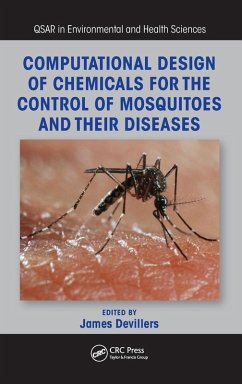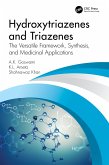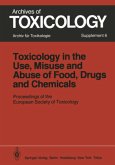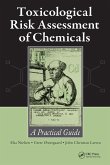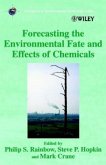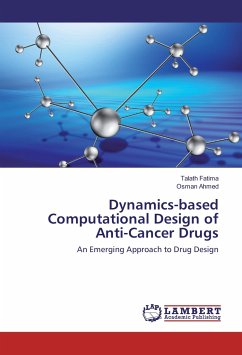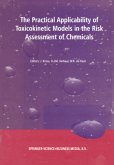Computational Design of Chemicals for the Control of Mosquitoes and Their Diseases
Herausgeber: Devillers, James
Computational Design of Chemicals for the Control of Mosquitoes and Their Diseases
Herausgeber: Devillers, James
- Gebundenes Buch
- Merkliste
- Auf die Merkliste
- Bewerten Bewerten
- Teilen
- Produkt teilen
- Produkterinnerung
- Produkterinnerung
There is a compelling need for new drugs and efficient treatments against mosquito-borne diseases. Computational Design of Chemicals for the Control of Mosquitoes and Their Diseases explains how the search for new substances effective against mosquitoes and their diseases has benefited from the use of in silico techniques.
Andere Kunden interessierten sich auch für
![Hydroxytriazenes and Triazenes Hydroxytriazenes and Triazenes]() A. K. GoswamiHydroxytriazenes and Triazenes195,99 €
A. K. GoswamiHydroxytriazenes and Triazenes195,99 €![Disease, Metabolism and Reproduction in the Toxic Response to Drugs and Other Chemicals Disease, Metabolism and Reproduction in the Toxic Response to Drugs and Other Chemicals]() Disease, Metabolism and Reproduction in the Toxic Response to Drugs and Other Chemicals82,99 €
Disease, Metabolism and Reproduction in the Toxic Response to Drugs and Other Chemicals82,99 €![Toxicology in the Use, Misuse, and Abuse of Food, Drugs, and Chemicals Toxicology in the Use, Misuse, and Abuse of Food, Drugs, and Chemicals]() Toxicology in the Use, Misuse, and Abuse of Food, Drugs, and Chemicals81,99 €
Toxicology in the Use, Misuse, and Abuse of Food, Drugs, and Chemicals81,99 €![Toxicological Risk Assessment of Chemicals Toxicological Risk Assessment of Chemicals]() Elsa NielsenToxicological Risk Assessment of Chemicals247,99 €
Elsa NielsenToxicological Risk Assessment of Chemicals247,99 €![Forecasting the Environmental Fate and Effects of Chemicals Forecasting the Environmental Fate and Effects of Chemicals]() Philip S. Rainbow / Steve P. Hopkin / Mark Crane (Hgg.)Forecasting the Environmental Fate and Effects of Chemicals337,99 €
Philip S. Rainbow / Steve P. Hopkin / Mark Crane (Hgg.)Forecasting the Environmental Fate and Effects of Chemicals337,99 €![Dynamics-based Computational Design of Anti-Cancer Drugs Dynamics-based Computational Design of Anti-Cancer Drugs]() Talath FatimaDynamics-based Computational Design of Anti-Cancer Drugs34,99 €
Talath FatimaDynamics-based Computational Design of Anti-Cancer Drugs34,99 €![The Practical Applicability of Toxicokinetic Models in the Risk Assessment of Chemicals The Practical Applicability of Toxicokinetic Models in the Risk Assessment of Chemicals]() The Practical Applicability of Toxicokinetic Models in the Risk Assessment of Chemicals116,99 €
The Practical Applicability of Toxicokinetic Models in the Risk Assessment of Chemicals116,99 €-
-
-
There is a compelling need for new drugs and efficient treatments against mosquito-borne diseases. Computational Design of Chemicals for the Control of Mosquitoes and Their Diseases explains how the search for new substances effective against mosquitoes and their diseases has benefited from the use of in silico techniques.
Hinweis: Dieser Artikel kann nur an eine deutsche Lieferadresse ausgeliefert werden.
Hinweis: Dieser Artikel kann nur an eine deutsche Lieferadresse ausgeliefert werden.
Produktdetails
- Produktdetails
- Verlag: CRC Press
- Seitenzahl: 484
- Erscheinungstermin: 4. Januar 2018
- Englisch
- Abmessung: 240mm x 161mm x 30mm
- Gewicht: 886g
- ISBN-13: 9781498741804
- ISBN-10: 1498741800
- Artikelnr.: 50563021
- Herstellerkennzeichnung
- Libri GmbH
- Europaallee 1
- 36244 Bad Hersfeld
- gpsr@libri.de
- Verlag: CRC Press
- Seitenzahl: 484
- Erscheinungstermin: 4. Januar 2018
- Englisch
- Abmessung: 240mm x 161mm x 30mm
- Gewicht: 886g
- ISBN-13: 9781498741804
- ISBN-10: 1498741800
- Artikelnr.: 50563021
- Herstellerkennzeichnung
- Libri GmbH
- Europaallee 1
- 36244 Bad Hersfeld
- gpsr@libri.de
PhD in ecotoxicology (1987, University Lyon I, France). Head of CTIS. Publications: 245 peer-reviewed papers and book chapters. 15 authored/edited books. Founding editor (1993) and editor-in-chief (1993 to present) of the journal SAR and QSAR in Environmental Research (Gordon & Breach Science Publishers and now Taylor & Francis). Co-Editor of the journal Toxicology Methods (Taylor & Francis, 1997 to 2002). Member of the editorial board of: Journal of Biological Systems (World Scientific, 1995 to 1997). Toxicology Mechanisms and Methods (Taylor & Francis, 2002 to 2009). Current Bioactive Compounds (Bentham Science Publishers, 2007 to 2014). Ecological Modelling (Elsevier, 1996 to present). Xenobiotica (Informa Healthcare, 1995 to present). Toxics (MDPI AG, 2013 to present). Organization or co-organization of 14 international meetings.
Contents. Series Introduction. Acknowledgments. Contributors. Chapter 1
Repurposing Insecticides and Drugs for the Control of Mosquitoes and their
Diseases. Chapter 2 Insect Olfactory System as the Target for
Computer-Aided Design of Mosquito Repellents. Chapter 3
OBP-Structure-Aided Repellent Discovery: An Emerging Tool towards the
Prevention of Mosquito-Borne Diseases. Chapter 4 Molecular Topology as a
Powerful Tool for Searching new Repellents and Novel Drugs against Diseases
Transmitted by Mosquitoes. Chapter 5 Pharmacophore modeling applied to
mosquito borne diseases. Chapter 6 Comparative MIA-QSAR Proteochemometric
Analysis of NS3 Protease Substrates in Dengue Virus. Chapter 7
Mosquito-Active Cry d -Endotoxins from Bacillus thuringiensis subsp.
israelensis: Structural Insights into the Toxin-Induced Pore Architecture.
Chapter 8 Structural Scaffolding for New Mosquito Larvicides. 9 SAR and
QSAR Modeling of Structurally Diverse Juvenoids Active on Mosquito Larvae.
Chapter 10 SAR predictions of benzoylphenylurea chitin synthesis inhibitors
active on larvae of Aedes aegypti. Chapter 11 Predicting the toxicity of
piperidines against female adults of Aedes aegypti. Chapter 12 Molecular
modeling studies of the inhibition by natural compounds of a mosquito
detoxification system, implication in mosquito vector control. Chapter 13
Critical review of models for exposure assessment of residents and
bystanders to adulticides used in mosquito control. Chapter 14
Occupational exposure scenarios and modeling in vector control. Chapter 15
Use of insecticides indoor for the control of mosquitoes: Exposure
scenarios and modeling. Index
Repurposing Insecticides and Drugs for the Control of Mosquitoes and their
Diseases. Chapter 2 Insect Olfactory System as the Target for
Computer-Aided Design of Mosquito Repellents. Chapter 3
OBP-Structure-Aided Repellent Discovery: An Emerging Tool towards the
Prevention of Mosquito-Borne Diseases. Chapter 4 Molecular Topology as a
Powerful Tool for Searching new Repellents and Novel Drugs against Diseases
Transmitted by Mosquitoes. Chapter 5 Pharmacophore modeling applied to
mosquito borne diseases. Chapter 6 Comparative MIA-QSAR Proteochemometric
Analysis of NS3 Protease Substrates in Dengue Virus. Chapter 7
Mosquito-Active Cry d -Endotoxins from Bacillus thuringiensis subsp.
israelensis: Structural Insights into the Toxin-Induced Pore Architecture.
Chapter 8 Structural Scaffolding for New Mosquito Larvicides. 9 SAR and
QSAR Modeling of Structurally Diverse Juvenoids Active on Mosquito Larvae.
Chapter 10 SAR predictions of benzoylphenylurea chitin synthesis inhibitors
active on larvae of Aedes aegypti. Chapter 11 Predicting the toxicity of
piperidines against female adults of Aedes aegypti. Chapter 12 Molecular
modeling studies of the inhibition by natural compounds of a mosquito
detoxification system, implication in mosquito vector control. Chapter 13
Critical review of models for exposure assessment of residents and
bystanders to adulticides used in mosquito control. Chapter 14
Occupational exposure scenarios and modeling in vector control. Chapter 15
Use of insecticides indoor for the control of mosquitoes: Exposure
scenarios and modeling. Index
Contents. Series Introduction. Acknowledgments. Contributors. Chapter 1
Repurposing Insecticides and Drugs for the Control of Mosquitoes and their
Diseases. Chapter 2 Insect Olfactory System as the Target for
Computer-Aided Design of Mosquito Repellents. Chapter 3
OBP-Structure-Aided Repellent Discovery: An Emerging Tool towards the
Prevention of Mosquito-Borne Diseases. Chapter 4 Molecular Topology as a
Powerful Tool for Searching new Repellents and Novel Drugs against Diseases
Transmitted by Mosquitoes. Chapter 5 Pharmacophore modeling applied to
mosquito borne diseases. Chapter 6 Comparative MIA-QSAR Proteochemometric
Analysis of NS3 Protease Substrates in Dengue Virus. Chapter 7
Mosquito-Active Cry d -Endotoxins from Bacillus thuringiensis subsp.
israelensis: Structural Insights into the Toxin-Induced Pore Architecture.
Chapter 8 Structural Scaffolding for New Mosquito Larvicides. 9 SAR and
QSAR Modeling of Structurally Diverse Juvenoids Active on Mosquito Larvae.
Chapter 10 SAR predictions of benzoylphenylurea chitin synthesis inhibitors
active on larvae of Aedes aegypti. Chapter 11 Predicting the toxicity of
piperidines against female adults of Aedes aegypti. Chapter 12 Molecular
modeling studies of the inhibition by natural compounds of a mosquito
detoxification system, implication in mosquito vector control. Chapter 13
Critical review of models for exposure assessment of residents and
bystanders to adulticides used in mosquito control. Chapter 14
Occupational exposure scenarios and modeling in vector control. Chapter 15
Use of insecticides indoor for the control of mosquitoes: Exposure
scenarios and modeling. Index
Repurposing Insecticides and Drugs for the Control of Mosquitoes and their
Diseases. Chapter 2 Insect Olfactory System as the Target for
Computer-Aided Design of Mosquito Repellents. Chapter 3
OBP-Structure-Aided Repellent Discovery: An Emerging Tool towards the
Prevention of Mosquito-Borne Diseases. Chapter 4 Molecular Topology as a
Powerful Tool for Searching new Repellents and Novel Drugs against Diseases
Transmitted by Mosquitoes. Chapter 5 Pharmacophore modeling applied to
mosquito borne diseases. Chapter 6 Comparative MIA-QSAR Proteochemometric
Analysis of NS3 Protease Substrates in Dengue Virus. Chapter 7
Mosquito-Active Cry d -Endotoxins from Bacillus thuringiensis subsp.
israelensis: Structural Insights into the Toxin-Induced Pore Architecture.
Chapter 8 Structural Scaffolding for New Mosquito Larvicides. 9 SAR and
QSAR Modeling of Structurally Diverse Juvenoids Active on Mosquito Larvae.
Chapter 10 SAR predictions of benzoylphenylurea chitin synthesis inhibitors
active on larvae of Aedes aegypti. Chapter 11 Predicting the toxicity of
piperidines against female adults of Aedes aegypti. Chapter 12 Molecular
modeling studies of the inhibition by natural compounds of a mosquito
detoxification system, implication in mosquito vector control. Chapter 13
Critical review of models for exposure assessment of residents and
bystanders to adulticides used in mosquito control. Chapter 14
Occupational exposure scenarios and modeling in vector control. Chapter 15
Use of insecticides indoor for the control of mosquitoes: Exposure
scenarios and modeling. Index

